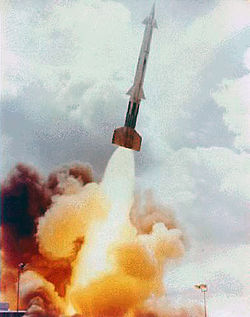
Back LIM-49 Nike Zeus Spanish LIM-49 Nike Zeus Finnish LIM-49 Nike Zeus French LIM-49 Nike Zeus Italian XLIM-49 Nike-Zeus Polish LIM-49 Nike Zeus Russian Nike Zeus Ukrainian Nike Zeus Vietnamese 奈基-宙斯导弹 Chinese
| Nike Zeus B | |
|---|---|
 Nike Zeus B test launch at White Sands | |
| Type | Anti-ballistic missile |
| Place of origin | United States |
| Service history | |
| Used by | US Army |
| Production history | |
| Manufacturer | |
| Produced | 1961 |
| Specifications | |
| Mass | 24,200 lb (11,000 kg) total |
| Length | 50 feet 2 inches (15.29 m) total |
| Diameter | 36 inches (910 mm) |
Detonation mechanism | radio command |
| Engine | 450,000 lbf (2,000 kN) booster |
Operational range | 230 nmi (430 km; 260 mi) |
| Flight ceiling | over 150 nmi (280 km; 170 mi) |
| Maximum speed | greater than Mach 4 (3,000 mph; 4,900 km/h) |
Guidance system | command guidance |
Launch platform | silo |
Nike Zeus was an anti-ballistic missile (ABM) system developed by the United States Army during the late 1950s and early 1960s that was designed to destroy incoming Soviet intercontinental ballistic missile warheads before they could hit their targets. It was designed by Bell Labs' Nike team, and was initially based on the earlier Nike Hercules anti-aircraft missile. The original, Zeus A, was designed to intercept warheads in the upper atmosphere, mounting a 25 kiloton W31 nuclear warhead. During development, the concept changed to protect a much larger area and intercept the warheads at higher altitudes. This required the missile to be greatly enlarged into the totally new design, Zeus B, given the tri-service identifier XLIM-49, mounting a 400 kiloton W50 warhead. In several successful tests, the B model proved itself able to intercept warheads, and even satellites.
The nature of the strategic threat changed dramatically during the period that Zeus was being developed. Originally expected to face only a few dozen ICBMs, a nationwide defense was feasible, although expensive. When the Soviets claimed to be building hundreds of missiles, the US faced the problem of building enough Zeus missiles to match them. The Air Force argued they close this missile gap by building more ICBMs of their own instead. Adding to the debate, a number of technical problems emerged that suggested Zeus would have little capability against any sort of sophisticated attack.
The system was the topic of intense inter-service rivalry throughout its lifetime. When the ABM role was given to the Army in 1958, the United States Air Force began a long series of critiques on Zeus, both within defense circles and in the press. The Army returned these attacks in kind, taking out full page advertisements in popular mass market news magazines to promote Zeus, as well as spreading development contracts across many states in order to garner the maximum political support. As deployment neared in the early 1960s, the debate became a major political issue. The question ultimately became whether a system with limited effectiveness would be better than nothing at all.
The decision whether to proceed with Zeus eventually fell to President John F. Kennedy, who became fascinated by the debate about the system. In 1963, the United States Secretary of Defense, Robert McNamara, convinced Kennedy to cancel Zeus. McNamara directed its funding toward studies of new ABM concepts being considered by ARPA, selecting the Nike-X concept, which addressed Zeus' various problems by using an extremely high-speed missile, Sprint, along with greatly improved radars and computer systems. The Zeus test site built at Kwajalein was briefly used as an anti-satellite weapon.
© MMXXIII Rich X Search. We shall prevail. All rights reserved. Rich X Search